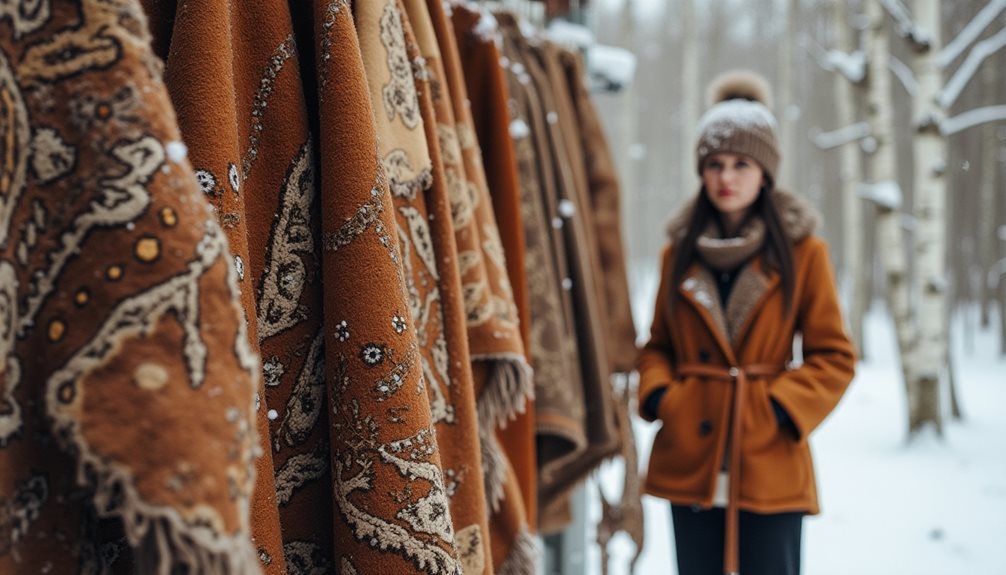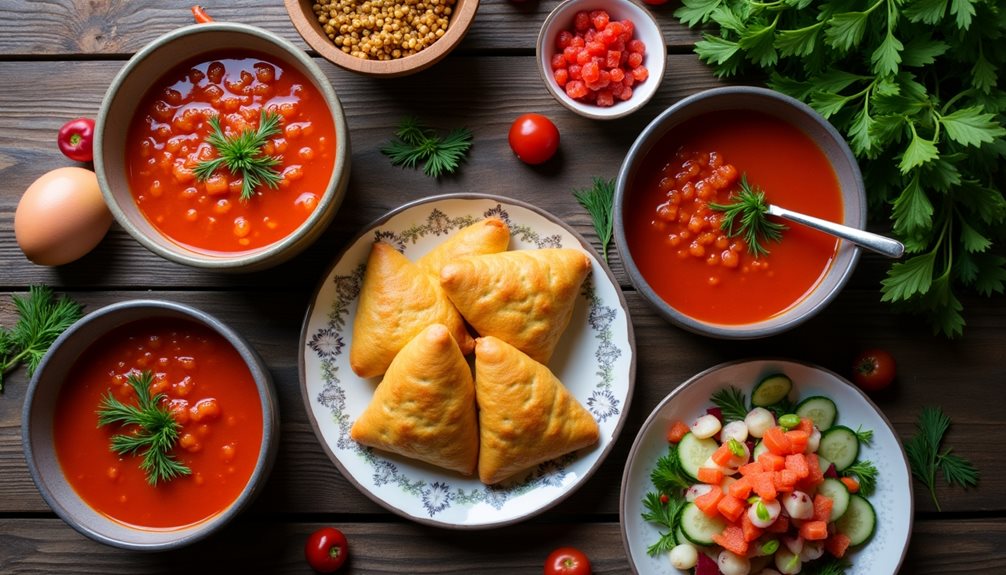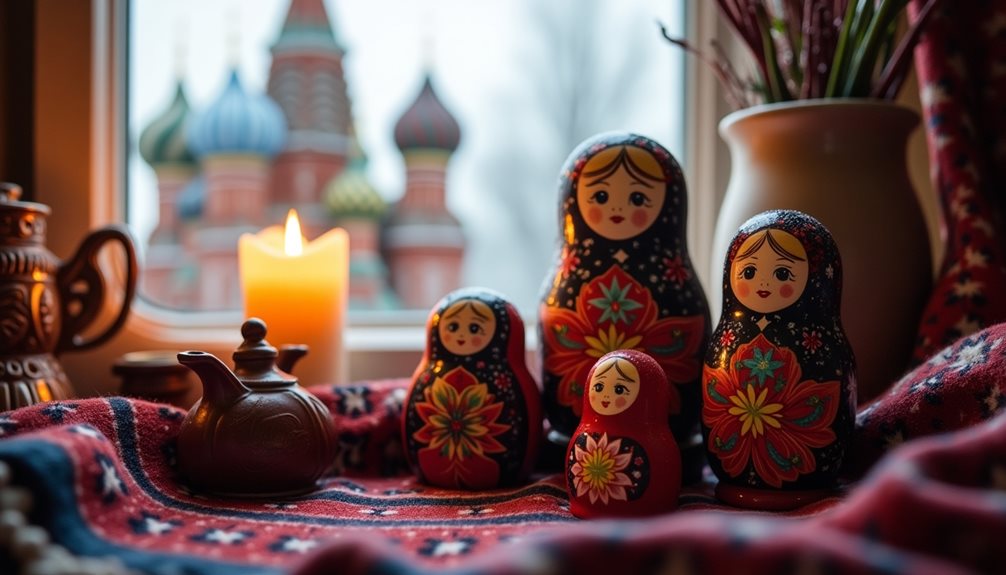When people picture Russian souvenirs, it’s easy to think of matryoshka dolls or Fabergé eggs. Yet, some of Russia’s most enduring cultural treasures are found in everyday life: the sturdy felt valenki boots, the classic fur-lined ushanka hat, the swirling cucumber paisley prints on shawls, and the crisp blue-and-white Gzhel ceramics. These objects are more than mere mementos—they’re woven into the fabric of Russian life and history.
Each of these items tells a story about the land, climate, and people that shaped them. Valenki kept generations warm through brutal winters; the ushanka became an unmistakable symbol of Russian resilience; cucumber paisley patterns carry whispers of trade routes and artistic exchange; Gzhel ceramics reflect centuries of craftsmanship and community identity. In this article, we explore the real origins and deeper meanings of these everyday treasures—reminding us that Russia’s story lives on in the things its people have made, worn, and cherished for centuries.
Valenki: Russia’s Iconic Felt Boots—A Story of Heritage and Style

Valenki, the iconic Russian felt boots, are much more than winter footwear—they are a powerful symbol of the country’s resilience, creativity, and deep cultural heritage. Though their earliest origins can be traced to the Pazyryk burial mounds of Central Asia, where archaeologists discovered ancient felt artifacts, valenki truly rose to prominence on Russian soil. Their adoption accelerated during the Mongol invasions, as hardy felt boots became essential for surviving harsh winters.
By the 18th century, Russian Old Believers perfected the art of seamless felting, transforming valenki into sturdy, impossibly warm boots. This innovation turned valenki into a household staple across Russia’s vast and frigid landscape. These boots were especially valued by peasants and soldiers—during World War II, valenki kept Soviet troops warm on the front lines, becoming a quiet symbol of Russian endurance.
Valenki are more than practical; they carry centuries of tradition. Each pair is handcrafted from pure sheep’s wool, reflecting the strong ties between Russian people and their natural environment. In folklore, valenki are often linked to prosperity and home comfort—children would hang small valenki near the stove to dry, a familiar winter scene in Russian villages.
Today, valenki have found new life in modern fashion. Designers add colorful embroidery and rubber soles, blending old-world charm with contemporary sensibilities. Worn on city streets and runways alike, valenki continue to celebrate Russian ingenuity and pride.
Understanding valenki means appreciating the heart of Russian culture: a blend of practicality, artistry, and steadfast tradition—warmth for both body and soul.
Kokoshnik: Russia’s Timeless Headdress of Grace and Tradition
The kokoshnik, with its elegant silhouette and intricate patterns, is one of the most recognizable symbols of Russian heritage and femininity. Worn for centuries by women across Russia, this distinctive headdress embodies the nation’s artistic soul and respect for tradition.
The kokoshnik’s origins reach far back, drawing inspiration from Byzantine court fashion and influences from Mongolian tribes encountered during Russia’s formative years. Over time, Russian artisans elevated the kokoshnik to a work of art, adorning it with pearls, embroidery, and fine fabrics to highlight a woman’s grace and dignity.
In traditional Russian society, the kokoshnik was more than just an accessory. It reflected deep-rooted beliefs: married women covered their hair as a sign of modesty and respect, while young girls wore simpler styles. Valued as a family heirloom, the kokoshnik was lovingly passed down through generations and was often worn at weddings, festivals, and important celebrations.
Despite attempts to discourage traditional dress during Peter the Great’s reforms in the 18th century, the kokoshnik endured—especially among merchant families and villagers who took pride in preserving Russian customs. It became a quiet act of cultural resistance and a symbol of national pride.
Today, the kokoshnik is enjoying a renaissance. Modern designers reinterpret its classic forms for fashion shows and cultural events, while Russian performers wear it on world stages. The kokoshnik now represents not only historical beauty but also the strength and resilience of Russian women.
To understand the kokoshnik is to appreciate the enduring spirit of Russia: an unwavering connection to heritage, a celebration of artistry, and pride in authentic femininity that continues to captivate hearts in Russia and beyond.
![]()
Gzhel Ceramics: The Fusion of Russian Craftsmanship and Dutch Influence
Gzhel ceramics, with their signature blue-and-white patterns, are celebrated around the world as a symbol of Russian craftsmanship and artistic spirit. The story of Gzhel is one of creativity, adaptation, and national pride.
The roots of Gzhel pottery date back to the early 18th century, during the reign of Peter the Great—a time when Russia was opening its doors to European influences. Inspired by the beauty of Dutch Delftware, Russian artisans in the village of Gzhel, just outside Moscow, began to experiment with new ceramic techniques. They adopted the blue-and-white palette but quickly developed their own unique style, infusing Russian motifs, folk tales, and floral ornaments into every piece.
What makes Gzhel ceramics truly special is the way Russian craftsmen transformed foreign art into something unmistakably their own. Each plate, teapot, and figurine is hand-painted, often with scenes from Russian village life or traditional fairy tales. The vibrant cobalt blue on a white background became a hallmark of quality and beauty, instantly recognized in Russian homes and abroad.
The village of Gzhel itself became a center of innovation and community pride. Families passed down their knowledge for generations, with workshops buzzing through the centuries. Even during challenging times—wars, political changes, economic hardships—the Gzhel tradition persisted, a testament to Russian resilience and love for their heritage.
Today, Gzhel ceramics are both cherished collectibles and practical items gracing everyday tables. They symbolize more than artistic skill; they represent Russia’s history of openness to new ideas while staying true to its roots. Gzhel is a living bridge between past and present, East and West—proof that Russian culture thrives on creativity and connection.
The Cucumber Paisley: The World-Travelling Motif in Russian Shawls
The cucumber paisley—known in Russia as “огурец” (ogurets)—is a pattern that has journeyed across centuries and continents, weaving its way into the fabric of Russian culture and style. With its curved, teardrop silhouette, this motif carries a story of tradition, symbolism, and international connection.
First appearing in the Sasanian Empire (Persia), the cucumber paisley originally symbolized fertility, abundance, and the renewal of life. Its shape and meaning resonated far beyond its birthplace, spreading through the Silk Road to India, East Asia, and Africa. In each new land, artisans adapted the design to local tastes, imbuing it with fresh interpretations while preserving its original character.
By the 18th century, Russian textile makers embraced the paisley pattern—especially at the renowned Pavlovo Posad Shawl Manufactory near Moscow. Here, the motif became a bestseller, taking on vibrant new colors and intricate arrangements unique to Russian artistry. Pavlovo Posad shawls featuring cucumber paisleys quickly became cherished accessories, admired for their beauty and warmth, and treasured as family heirlooms.
The pattern’s adoption in Russia is more than a tale of fashion; it speaks to Russia’s openness to global influences while transforming them into something distinctly their own. The paisley’s journey from ancient Persia to Russian shawls highlights the creative dialogue between cultures—and the importance of artistic exchange in enriching national identity.
Today, the cucumber paisley remains a beloved element in Russian design, connecting wearers to a vast tapestry of history and craftsmanship. Its presence in modern fashion is a reminder of Russia’s place in the wider world—a country shaped by both its proud heritage and its embrace of global inspiration.
Ushanka: Russia’s Iconic Winter Hat of Warmth and Heritage
The ushanka, with its distinctive ear flaps and snug fit, stands as one of Russia’s most recognizable symbols—synonymous with cold winters and enduring spirit. But the story of the ushanka is also one of adaptation, cultural exchange, and national pride.
Long before it became a Russian classic, the idea for the ushanka was shaped by ancient Central Asian traditions. Craftsmen in these regions crafted pointed felt helmets with protective ear flaps, similar to the Mongolian malakhay. As people and ideas moved across the Eurasian steppe, Russian artisans adopted and refined these designs, creating a hat uniquely suited to their own extreme climate.
The genius of the ushanka lies in its practicality. Made from sheepskin, fur, or heavy cloth, the ear flaps can be tied up or let down to shield the face from icy winds. This simple yet effective design has made the ushanka indispensable from rural villages to bustling cities—anywhere warmth and comfort are needed.
The ushanka’s place in Russian culture grew even stronger when it became part of the Red Army uniform in 1940. The sight of soldiers in ushankas during World War II cemented the hat as a symbol of resilience and unity, representing the strength of the Russian people in challenging times.
Today, the ushanka is much more than winter gear. It is a proud emblem of Russian identity—worn by everyone from schoolchildren to statesmen, featured in folk art, and embraced by designers who give it new twists for modern fashion. Its journey from Central Asian origins to Russian icon shows how cultural exchange can lead to something both practical and deeply meaningful.
Wearing an ushanka means embracing the warmth and strength at the heart of Russian culture—a tradition that continues to unite generations through function, style, and a shared sense of belonging.
Russia’s Living Treasures: Heritage Woven Into Everyday Life
These treasures—valenki, kokoshnik, Gzhel ceramics, paisley shawls, and the ushanka—are more than souvenirs or symbols. They are living links between Russia’s past and its present, crafted by countless hands and shaped by centuries of resilience, artistry, and exchange. Each object carries layers of meaning: warmth and protection, beauty and identity, openness to the world, and pride in what is uniquely Russian.
To truly understand Russia, look beyond the postcards and keepsakes. Notice how everyday life is colored by these traditions—how a pair of felt boots by the stove, a splash of cobalt on a teapot, or the sweep of a shawl over a shoulder still connect people to their roots. These are stories that can’t be bought in a gift shop; they are inherited, lived, and shared.
In a country where winters are long and history runs deep, culture is not just preserved in museums but carried forward in daily rituals and cherished objects. Russia’s true treasures are the ones its people continue to make their own—reminders that heritage is alive, practical, beautiful, and always evolving.





